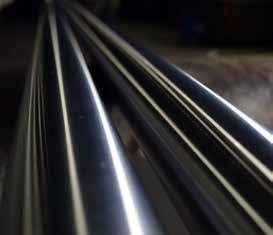
Microsteel® CHROME-NICKEL-MOLY ALLOY STEEL
MICROSTEEL®
Microsteel® is a tough, shock and fatigue resisting Chrome-Nickel- Moly alloy steel provided in the turned-ground and polished condition. In the delivered quenched and tempered condition, it has the highest combination of tensile strength and ductility while maintaining comparable high machinability.
Bars are delivered in turned-ground and polished condition, with a hardness range of 269-341 BHN. For most applications, Microsteel is both hard and tough enough to be used without additional hardening. Microsteel is quenched and tempered, stress relieved and machine straightened prior to shipment. This process insures proper grain structure alignment, removal of longitudinal stress factors and confines hardness range to within 2% variance in any bar or plate section. Most aircooled alloy products, except tool steel, cannot meet these qualifications. A slight reduction in hardness from surface to core is more desirable than “air hardened steel” since this process provides much higher ductility and resistance to shock.
Advantages
- Superior Fatigue Strength
- Deep Hardened
- High Tensile & Yield Strength
- High Shear Strength
- Uniform Fine Grain Structure
- Easily Machinable
- Fully Stress Relieved
- Machine Straightened
- Demagnetized

Microsteel® vs. 4140
(As Quenched Hardness (Rc))

Available Stock Sizes
| Tolerance | |
|---|---|
| Diameters | Limits |
| 7/16″ through 4″ | +.000 - .002 |
| 41/8″ through 6″ | +.000 - .003 |
| Length |
|---|
| 0.5 - 25 Ft. (cut to length) |
| Diameter |
|---|
| 7/16″ through 6″ in 1/16″ increments |
Chemistry(%)
| C | Mn | P | S | Si | Ni | Cr | Mo |
|---|---|---|---|---|---|---|---|
| .37-.43 | .60-.85 | .035* | .04* | .15-.30 | 1.65-2.00 | .70-.90 | .20-.30 |
*max %
Physical Constants:
| Density | 0.283 lb/in3 |
| Melting point | 2600 °F |
| Thermal conductivity (typical steel) | 309 BTU in/hr.ft².°F |
| Coefficient thermal expansion | 68°F, specimen oil hardened, 1110°F temper …....…..6.83 μin/in°F |
| Electric resistivity(68°F ) | 2.48x10-5Ohm*cm |
| Electric resistivity(212°F ) | 2.98x10-5Ohm*cm |
| Elastic modulus | 27557-30458 ksi |
Typical Properties
| Annealed | Normalized | Drawn | |
|---|---|---|---|
| Tensile Strength, psi | 120000 | 180000 | 142000 |
| Yield Strength, psi | 80000 | 145000 | 110000 |
| Elongation, % in 2" | 18 | 8 | 20 |
| Reduction of Area, % | 35 | 22 | 38 |
| Brinell Hardness | 250 | 370 | 260 |
Low Temp. Charpy Impact
Ft. Lbs. (V-Notch)
| Temperature of Test | ||||
|---|---|---|---|---|
| Normalized Hardened | +68° F | +14° F | -10° F | -94° F |
| Normalized 40Rc | 12.4 | 7.4 | 6.4 | 4.8 |
| Hardened 35Rc | 81.8 | 82.3 | 87.1 | 77.3 |
| Hardened 28Rc | 93.6 | 78.0 | 74.8 | 36.0 |
FABRICATION
We recommend the use of St. Lawrence’s comprehensive fabrication services to eliminate processing and fabrication errors.
Cutting Keyways
Use a four or six fluted high-speed end mill; with widths up to 1/2″, use up to 60 RPM; over 1/2″ wide, reduce RPM to the 25 – 40 range. Take the full depth of keyways up to 5/8″ deep in one pass. Use two passes for depths greater than 5/8″. Use coolant to keep the cutter and steel cool. A special word about keyways – the majority of fatigue failures in shafting made from any steel can be traced back to sharp corners and notches like those found at the base of a squared corner keyway. To greatly increase your shafting life, put a small radius at the corners of the key- ways and place a corresponding radius on the matching corners of the key.
Machining
Microsteel has a fine grain microstructure (8-9) with closely controlled carbide particles which provide improved machinability. The oil quench and temper process of Microsteel, followed by controlled stress relieving, insures against distortion and run-out commonly found in air-hardened alloys. Turning, boring and facing is more easily accomplished using mated tungsten-carbide inserts with chip-breaker. Always refer to your equipment user manual for recommended setting.
WELDING
Microsteel has good welding characteristics. It can be readily gas or arc welded. Welding electrodes of close to the same composition are recommended. Be sure to use a dry mated rod when arc welding. This process will retard excess grain growth. Preheating to 250° F is suggested. Since Microsteel has air hardening properties, stress relieving or normalizing following the welding process is recommended. Post-heating to 300- 350° F is also acceptable.
Turning
| High Speed Steel Tool | ||
|---|---|---|
| Cut Depth | Speed fpm | Feed ipr |
| .150 | 50 | .010 |
| .025 | 65 | .005 |
Drilling
Using HSS Tool Material
| Feed - Inches Per Revolution Normal Hole Diameter - Inches |
|||||||
|---|---|---|---|---|---|---|---|
| Speed fpm | 1/8 | .003 | .004 | .004 | .006 | .006 | .008 |
| 35 | .002 | .003 | .003 | .004 | .006 | .006 | .008 |
